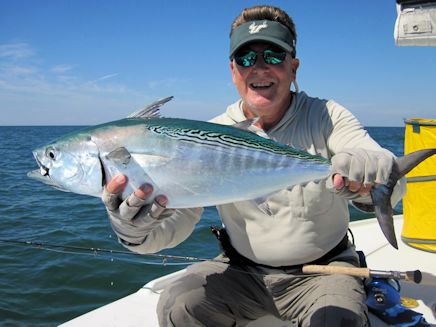Capt. Rick Grassett’s Sarasota, FL Fly Fishing Forecast for October 2016
The area including Tampa Bay, Sarasota Bay, Charlotte Harbor and the coastal Gulf of Mexico will turn on this month. Schools of reds begin to break up and scatter on shallow flats. There should also be good action with snook and big trout in shallow water. Snook will gorge themselves at night around lighted docks in the ICW. There will also be good action in the coastal gulf with Spanish mackerel, false albacore (little tunny), tripletail and cobia. You might also still find tarpon anywhere from upper Charlotte Harbor and Tampa Bay to along the beaches.
Snook will move away from passes as water temperature cools and days get shorter. They will stage around docks and bridges in the ICW and along sand bars, potholes and along mangrove shorelines. They may blow up on fly poppers in shallow water early or late in the day. Small white flies or Gurglers should work well around lighted docks and bridge fenders. I like larger flies, like Lefty’s Deceiver and EP flies, for snook on the flats due to the larger bait usually found there. Fish peak tidal flows for the best action.
Tarpon will still be an option this month. I’ve found them in upper Charlotte Harbor this time of year. Look for them feeding in ladyfish schools or rolling in deep water to find them. Many of the same flies that work for sight casting to tarpon along the beaches will work in upper Charlotte Harbor. I use 12-wt fly tackle with a floating or clear intermediate sink tip line for large tarpon. You’ll also find juvenile tarpon from 10 to 30-pounds in many creeks and canals of the Peace or Myakka Rivers. Fly anglers can handle the smaller fish on 8 or 9-wt fly rods with sink tip fly lines and a scaled down version of any fly that large tarpon will eat. I’ve also found tarpon feeding heavily in the coastal gulf in October. They are usually scattered over a broad area, feeding and “blowing up” in bait schools. This “reverse migration” may only last for a few days but it can be really good!
Big schools of reds that are more common in August and September will begin to break up into smaller schools, singles and doubles this month. As water cools and baitfish school up, reds will feed in shallow water. I like to pole my flats skiff to hunt for reds in shallow water. Focus on baitfish or mullet schools to find them. If the tide is very low, weed guards are important on your flies to fish thick turtle grass. Once I’ve located fish, wading is often the best way to approach them. I like a long leader (12’) on a floating fly line with a lightly weighted fly, like my Grassett Flats Minnow. When you have good sunlight, you may be able to sight fish them on light colored bottom, like sandbars or potholes.
You’ll also find big trout in many of the same areas in shallow water. I would approach locating big trout the same way as reds. Focus on baitfish or mullet schools to find them and use the same flies to catch them. Some of the best action that I’ve experienced with big trout was at first light with big trout feeding in baitfish schools in very shallow water.
You’ll find trout of all sizes on deep grass flats. Wherever there are small trout, there may be a few “gators” around since big trout will eat small ones. You should also find blues, Spanish mackerel or pompano mixed with trout. In addition to focusing on bait and birds, I like to drift and cast ahead of the drift with a lightly weighted fly on a sink tip fly line to find fish. When toothy fish are around add 6”of heavy fluorocarbon (60-lb) or wire to prevent cut offs. You may find tripletail or cobia around buoys, crab trap floats or channel markers in inside waters or the coastal gulf. Fly anglers should score on tripletail with lightly weighted flies with a weed guard. A wide profile tarpon fly on a minimum of 9-weight fly tackle will get the job done with cobia.
Look for Spanish and king mackerel or false albacore in the coastal gulf. I look for diving terns or “breaking” fish to find them. Fly anglers should score with olive, chartreuse or white flies, poppers and Crease flies. You’ll need wire or heavy fluorocarbon when mackerel are in the mix. You may also find a few kings around the edges of feeding frenzies. I don’t usually target kings, but occasionally catch one when fishing breaking mackerel or albies. You can also look for tripletail or cobia around crab trap floats, buoys or channel markers while searching for mackerel or albies in the coastal gulf.
October is one of my favorite months. It’s nice to do something different, so I like to fish the coastal gulf for mackerel, false albacore, tripletail and cobia when conditions are good. There will also be good action on shallow flats with reds, trout and snook or tarpon of all sizes in upper Charlotte Harbor. Night snook fishing in the ICW heats up as the water cools down. Whatever you choose to do, please limit your kill, don’t kill your limit!
Tight Lines,
Capt. Rick Grassett
IFFF Certified Fly Casting Instructor
Orvis-Endorsed Fly Fishing Guide at CB’s Saltwater Outfitters
Orvis Outfitter of the Year-2011
Snook Fin-Addict Guide Service, Inc.
www.snookfin-addict.com, www.snookfinaddict.com and www.flyfishingflorida.us
E-mail snookfin@aol.com
(941) 923-7799
Latest posts by Capt. Rick Grassett (see all)
- Sarasota, Rick Grassett - March 12, 2024
- Grasssett Fly March - March 3, 2024
- Grassett March - March 3, 2024











